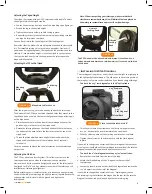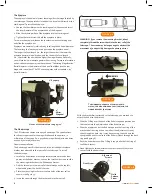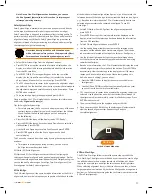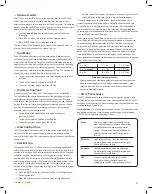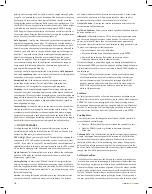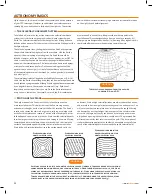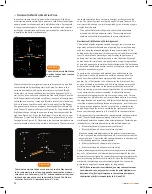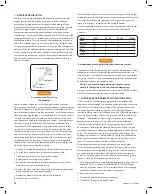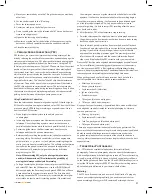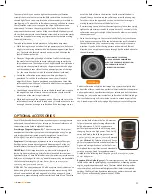
16
>>
www
.celestron
.com
guiding on a star using an off-axis guider versus a straight through guide
scope . To compensate for this, the direction of the drive control keys can
be changed . To reverse the button logic of the hand control, press the
MENU button and select Direction Buttons from the Utilities menu . Use
the UP/DOWN arrow keys (10) to select either the azimuth (left and right)
or altitude (up and down) button direction and press ENTER . Pressing
ENTER again will reverse the direction of the hand control buttons from
their current state . Direction Buttons will only change the eyepiece rates
(rate 1-6) and will not affect the slew rates (rate 7-9).
GoTo Approach – lets the user define the direction that the telescope will
approach when slewing to an object. This allows the user the ability to
minimize the effects of backlash. For example, if your telescope is back
heavy from using heavy optical or photographic accessories attached to
the back, you would want to set your altitude approach to the negative
direction . This would ensure that the telescope always approaches an
object from the opposite direction as the load pulling on the scope.
Similarly, if using the CPC polar aligned on a wedge, you would want
to set the azimuth approach to the direction that allows the scope to
compensate for different load level on the motors and gears when
pointing in different parts of the sky.
To change the GoTo approach direction, simply choose GoTo Approach
from the Scope Setup menu, select either Altitude or Azimuth approach,
choose positive or negative and press ENTER .
Autoguide Rate – Allows the user to set an autoguide rate as a
percentage of sidereal rate . This is helpful when calibrating your
telescope to a CCD autoguider for long exposure photography .
Cordwrap – Cord wrap safeguards against the telescope slewing more
than 360º in azimuth and wrapping accessory cables around the base of
the telescope . This is useful when autoguiding or any time that cables are
plugged into the base of the telescope . By default, the cord wrap feature
is turned off when the telescope is aligned in altazimuth and turned on
when aligned on a wedge .
Custom Rate 9 – Allows the user to set the maximum slew speed when
slewing to an object or pressing the arrow buttons while at rate 9. This
provides more controlled slews when equipped with delicate imaging
equipment for example. User defined rates can be set for both the RA
and Dec axes . Enabling and disabling this feature will allow you to toggle
back and forth between the custom setting and the default setting .
>>
Utility Features
Scrolling through the MENU (9) options will also provide access to
several advanced utility functions within the CPC such as; Periodic Error
Correction, Hibernate, as well as many others .
GPS On/Off – Allows you to turn off the GPS module. When aligning the
telescope, the CPC still receives information, such as current time, from
the GPS. If you want to use the CPC database to find the coordinates of a
celestial object for a future date, you would need to turn the GPS module
off in order to manually enter a date and time other than the present.
Lights Control – This feature allows you to turn off both the red key pad
light and LCD display for daytime use to conserve power and to help
preserve your night vision .
Factory Setting – Returns the CPC hand control to its original factory
setting . Parameters such as backlash compensation values, initial date
and time, longitude/latitude along with slew and filter limits will be reset.
The hand control will ask you to press the “0” key before returning to the
factory default setting .
Version – Selecting this option will allow you to see the current version
number of the hand control and motor control software. The first set
of numbers indicates the hand control software version. For the motor
control, the hand control will display two sets of numbers; the first
numbers are for azimuth and the second set are for altitude .
Get Axis Position – Displays the relative altitude and azimuth for the
current position of the telescope .
GoTo Axis Position – Allows you to enter a specific altitude and azimuth
position and slew to it .
Hibernate – Hibernate allows the CPC to be completely powered down
and still retain its alignment when turned back on . This not only saves
power, but is ideal for those that have their telescopes permanently
mounted or leave their telescope in one location for long periods of time .
To place your telescope in Hibernate mode:
1 . Select Hibernate from the Utility Menu .
2 . Move the telescope to a desired position and press ENTER .
3. Power off the telescope. Remember to never move your
telescope manually while in Hibernate mode .
Once the telescope is powered on again, the display will read Wake Up.
After pressing ENTER, you have the option of scrolling through the time/
site information to confirm the current setting. Press ENTER to wake up
the telescope .
Pressing UNDO at the Wake Up screen allows you to explore many
of the features of the hand control without waking the telescope
up from Hibernate mode. To wake up the telescope after UNDO
has been pressed, select Hibernate from the Utility menu and press
ENTER. Do not use the direction buttons to move the telescope
while in Hibernate mode.
Sun Menu
For safety purposes the Sun will not be displayed as a database object
unless it is first enabled. To enable the Sun, go to the Sun Menu and press
ENTER . The Sun will now be displayed in the Planets catalog and can
be used as an alignment object when using the Solar System Alignment
method . To remove the Sun from displaying on the hand control, once
again select the Sun Menu from the Utilities Menu and press ENTER .
Scrolling Menu
This menu allows you to change the rate of speed that the text scrolls
across the hand control display .
• Press the UP (number 6) button to increase the speed of the text.
• Press the DOWN (number 9) button to decrease the speed
of the text .
Calibrate GoTo – GoTo Calibration is a useful tool when attaching heavy
visual or photographic accessories to the telescope . GoTo Calibration
calculates the amount of distance and time it takes for the mount to
complete its final slow GoTo when slewing to an object. Changing the
balance of the telescope can prolong the time it takes to complete the
final slew. GoTo Calibration takes into account any slight imbalances and
changes the final GoTo distance to compensate.
Set Mount Position
The Set Mount Position menu can be used to maintain your alignment
in cases where you wish to disengage the clutches or similar situations .
For instance, you might use this feature if you needed to rebalance the
mount after having completed an alignment . To set the mount position
simply slew to a bright star in the named star list then select Set Mount
Position . The hand control will sync on the star by asking you to center
the star in the eyepiece and pressing the Align button. Once synced on
the star, you are free to manually move the mount in both axes in order
Summary of Contents for 11007
Page 1: ...InstructionManual 11007 11008 11009...
Page 2: ...www celestron com...
Page 40: ...38 www celestron com APPENDIXD MAPSOFTIMEZONES...
Page 41: ...www celestron com 39...
Page 42: ...40 www celestron com APPENDIXE SKYMAPS...
Page 43: ...www celestron com 41...
Page 44: ...42 www celestron com...
Page 45: ...www celestron com 43...
Page 46: ...44 www celestron com...
Page 47: ...www celestron com 45...




